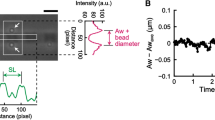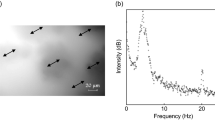Abstract
In living systems, irreversible, yet stochastic, molecular interactions form multiscale structures (such as cytoskeletal networks), which mediate processes (such as cytokinesis and cellular motility) in a close relationship between the structure and function. However, owing to a lack of methods to quantify non-equilibrium activity, their dynamics remain poorly characterized. Here, by measuring the time-reversal asymmetry encoded in the conformational dynamics of filamentous single-walled carbon nanotubes embedded in the actomyosin network of Xenopus egg extract, we characterize the multiscale dynamics of non-equilibrium activity encoded in bending-mode amplitudes. Our method is sensitive to distinct perturbations to the actomyosin network and the concentration ratio of adenosine triphosphate to adenosine diphosphate. Thus, our method can dissect the functional coupling of microscopic dynamics to the emergence of larger scale non-equilibrium activity. We relate the spatiotemporal scales of non-equilibrium activity to the key physical parameters of a semiflexible filament embedded in a non-equilibrium viscoelastic environment. Our analysis provides a general tool to characterize steady-state non-equilibrium activity in high-dimensional spaces.
This is a preview of subscription content, access via your institution
Access options
Access Nature and 54 other Nature Portfolio journals
Get Nature+, our best-value online-access subscription
$29.99 / 30 days
cancel any time
Subscribe to this journal
Receive 12 print issues and online access
$259.00 per year
only $21.58 per issue
Buy this article
- Purchase on Springer Link
- Instant access to full article PDF
Prices may be subject to local taxes which are calculated during checkout




Similar content being viewed by others
Data availability
The data that support the plots within this paper and other findings of this study are available from the corresponding author upon reasonable request.
Code availability
The computational methods that support the plots within this paper are described in the Supplementary Information and the underlying code is available from the corresponding author upon reasonable request.
References
Needleman, D. & Dogic, Z. Active matter at the interface between materials science and cell biology. Nat. Rev. Mater. 2, 17048 (2017).
Ramaswamy, S. The mechanics and statistics of active matter. Annu. Rev. Condens. Matter Phys. 1, 323–345 (2010).
Marchetti, M. et al. Hydrodynamics of soft active matter. Rev. Mod. Phys. 85, 1143–1189 (2013).
Bowick, M., Fakhri, N., Marchetti, M. & Ramaswamy, S. Symmetry, thermodynamics, and topology in active matter. Phys. Rev. X 12, 010501 (2022).
Yang, X. et al. Physical bioenergetics: energy fluxes, budgets, and constraints in cells. Proc. Natl Acad. Sci. USA 118, e2026786118 (2021).
Tan, T. et al. Self-organized stress patterns drive state transitions in actin cortices. Sci. Adv. 4, eaar2847 (2018).
Gladrow, J., Fakhri, N., MacKintosh, F. C., Schmidt, C. F. & Broedersz, C. P. Broken detailed balance of filament dynamics in active networks. Phys. Rev. Lett. 116, 248301 (2016).
Landau, L., Lifshitz, E., Sykes, J., & Reid, W. Theory of Elasticity (Addison-Wesley 1959).
Brangwynne, C. P., Koenderink, G. H., MacKintosh, F. C. & Weitz, D. A. Nonequilibrium microtubule fluctuations in a model cytoskeleton. Phys. Rev. Lett. 100, 118104 (2008).
England, J. L. Dissipative adaptation in driven self-assembly. Nat. Nanotechnol. 10, 919–923 (2015).
Mizuno, D., Tardin, C., Schmidt, C. F. & MacKintosh, F. C. Nonequilibrium mechanics of active cytoskeletal networks. Science 315, 370–373 (2007).
Battle, C. et al. Broken detailed balance at mesoscopic scales in active biological systems. Science 352, 604–607 (2016).
Egolf, D. A. Equilibrium regained: from nonequilibrium chaos to statistical mechanics. Science 287, 101–104 (2000).
Prost, J., Jülicher, F. & Joanny, J-F. Active gel physics. Nat. Phys. 11, 111–117 (2015).
O’Byrne, J., Kafri, Y., Tailleur, J. & van Wijland, F. Time irreversibility in active matter, from micro to macro. Nat. Rev. Phys. 4, 167–183 (2022).
Gnesotto, F. S., Mura, F., Gladrow, J. & Broedersz, C. P. Broken detailed balance and non-equilibrium dynamics in living systems: a review. Rep. Prog. Phys. 81, 066601 (2018).
Fakhri, N. et al. High-resolution mapping of intracellular fluctuations using carbon nanotubes. Science 344, 1031–1035 (2014).
Fakhri, N., Tsyboulski, D. A., Cognet, L., Weisman, R. B. & Pasquali, M. Diameter-dependent bending dynamics of single-walled carbon nanotubes in liquids. Proc. Natl Acad. Sci. USA 106, 14219–14223 (2009).
Fakhri, N., MacKintosh, F. C., Lounis, B., Cognet, L. & Pasquali, M. Brownian motion of stiff filaments in a crowded environment. Science 330, 1804–1807 (2010).
Murrell, M. P. & Gardel, M. L. F-actin buckling coordinates contractility and severing in a biomimetic actomyosin cortex. Proc. Natl Acad. Sci. USA 109, 20820–20825 (2012).
Weiss, J. B. Coordinate invariance in stochastic dynamical systems. Tellus A 55, 208–218 (2003).
Crooks, G. E. Entropy production fluctuation theorem and the nonequilibrium work relation for free energy differences. Phys. Rev. E 60, 2721–2726 (1999).
Ro, S. et al. Model-free measurement of local entropy production and extractable work in active matter. Phys. Rev. Lett. 129, 220601 (2022).
Harunari, P. E., Dutta, A., Polettini, M. & Roldán, É. What to learn from a few visible transitions' statistics? Phys. Rev. X 12, 041026 (2022).
van der Meer, J., Ertel, B. & Seifert, U. Thermodynamic inference in partially accessible Markov networks: a unifying perspective from transition-based waiting time distributions. Preprint at https://arxiv.org/abs/2203.07427 (2022).
van der Meer, J., Degünther, J. & Seifert, U. Time-resolved statistics of snippets as general framework for model-free entropy estimators. Preprint at https://arxiv.org/abs/2211.17032 (2022).
Roldán, E., Barral, J., Martin, P., Parrondo, J. M. R. & Jülicher, F. Quantifying entropy production in active fluctuations of the hair-cell bundle from time irreversibility and uncertainty relations. New J. Phys. 23, 083013 (2021).
Tucci, G. et al. Modeling active non-Markovian oscillations. Phys. Rev. Lett. 129, 030603 (2022).
Skinner, D. J. & Dunkel, J. Improved bounds on entropy production in living systems. Proc. Natl Acad. Sci. USA 118, e2024300118 (2021).
Weiss, J. B., Fox-Kemper, B., Mandal, D., Nelson, A. D. & Zia, R. K. P. Nonequilibrium oscillations, probability angular momentum, and the climate system. J. Stat. Phys. 179, 1010–1027 (2020).
Gonzalez, J. P., Neu, J. C. & Teitsworth, S. W. Experimental metrics for detection of detailed balance violation. Phys. Rev. E 99, 022143 (2019).
Zia, R. K. P., Weiss, J. B., Mandal, D. & Fox-Kemper, B. Manifest and subtle cyclic behavior in nonequilibrium steady states. J. Phys. Conf. Ser. 750, 012003 (2016).
Li, J., Horowitz, J. M., Gingrich, T. R. & Fakhri, N. Quantifying dissipation using fluctuating currents. Nat. Commun. 10, 1666 (2019).
Guo, M. et al. Probing the stochastic, motor-driven properties of the cytoplasm using force spectrum microscopy. Cell 158, 822–832 (2014).
MacKintosh, F. C. & Levine, A. J. Nonequilibrium mechanics and dynamics of motor-activated gels. Phys. Rev. Lett. 100, 018104 (2008).
Malik-Garbi, M. et al. Scaling behaviour in steady-state contracting actomyosin networks. Nat. Phys. 15, 509–516 (2019).
MacKintosh, F. C., Käs, J. & Janmey, P. A. Elasticity of semiflexible biopolymer networks. Phys. Rev. Lett. 75, 4425–4428 (1995).
Valentine, M. T., Perlman, Z. E., Mitchison, T. J. & Weitz, D. A. Mechanical properties of Xenopus egg cytoplasmic extracts. Biophys. J. 88, 680–689 (2005).
Field, C. M., Pelletier, J. F. & Mitchison, T. J. in Methods in Cell Biology: Cytokinesis Vol. 137 (ed. Echard, A.) 395–435 (Academic, 2017).
Riedl, J. et al. Lifeact: a versatile marker to visualize F-actin. Nat. Methods 5, 605–607 (2008).
Chen, D. T., Heymann, M., Fraden, S., Nicastro, D. & Dogic, Z. ATP consumption of eukaryotic flagella measured at a single-cell level. Biophys. J. 109, 2562–2573 (2015).
Ruhnow, F., Zwicker, D. & Diez, S. Tracking single particles and elongated filaments with nanometer precision. Biophys. J. 100, 2820–2828 (2011).
Acknowledgements
We thank J.M. Horowitz and T.R. Gingrich for discussions. N.F. acknowledges support from a Sloan Research Fellowship, a Human Frontier Science Program Career Development Award (HFSP CDA-00053/2016C) and a Gordon and Betty Moore Foundation Grant (Grant No 7729). A.B. acknowledges support from a National Defense Science and Engineering Graduate Fellowship. J.F.P. acknowledges support from a Fannie and John Hertz Foundation Fellowship and an International Human Frontier Science Program Organization Cross-Disciplinary Fellowship (LT000901/2021-C).
Author information
Authors and Affiliations
Contributions
N.F. conceived and supervised the project. A.B. and J.F.P. designed and performed experiments. A.B. developed the theory, performed simulations and analysed data. Y.J. built the imaging setup. All authors discussed the results and co-wrote the paper.
Corresponding author
Ethics declarations
Competing interests
The authors declare no competing interests.
Peer review
Peer review information
Nature Nanotechnology thanks Jacinta Conrad and Sarah Loos for their contribution to the peer review of this work.
Additional information
Publisher’s note Springer Nature remains neutral with regard to jurisdictional claims in published maps and institutional affiliations.
Supplementary information
Supplementary Information
Supplementary Tables 1 and 2, Figs. 1–20 and Theory Sections 2.1–2.10.
Supplementary Video 1
Temporal dynamics of active actomyosin network in Xenopus egg extract.
Supplementary Video 2
Temporal dynamics of carbon nanotube filament in passive viscous medium (water).
Supplementary Video 3
Temporal dynamics of carbon nanotube filament in passive viscoelastic medium (actin gel).
Supplementary Video 4
Temporal dynamics of carbon nanotube filament in active actomyosin network (Xenopus egg extract).
Supplementary Video 5
Temporal evolution of ensemble-averaged mode correlation tensor for active wild-type/passive gels.
Supplementary Video 6
Temporal evolution of ensemble-averaged mode correlation tensor for active wild-type/active gels treated with cytochalasin D.
Supplementary Video 7
Temporal evolution of ensemble-averaged mode correlation tensor for active wild-type/active gels treated with α-actinin.
Supplementary Video 8
Temporal evolution of ensemble-averaged mode correlation tensor for active wild-type/active gels treated with apyrase.
Rights and permissions
Springer Nature or its licensor (e.g. a society or other partner) holds exclusive rights to this article under a publishing agreement with the author(s) or other rightsholder(s); author self-archiving of the accepted manuscript version of this article is solely governed by the terms of such publishing agreement and applicable law.
About this article
Cite this article
Bacanu, A., Pelletier, J.F., Jung, Y. et al. Inferring scale-dependent non-equilibrium activity using carbon nanotubes. Nat. Nanotechnol. 18, 905–911 (2023). https://doi.org/10.1038/s41565-023-01395-2
Received:
Accepted:
Published:
Issue Date:
DOI: https://doi.org/10.1038/s41565-023-01395-2
This article is cited by
-
Measurement of scale-dependent time-reversal asymmetry in biological systems
Nature Nanotechnology (2023)



